'Luv Tub' Takes on Marine Industry Giant in eBoat Challenge
Sure, Brunswick's 13-Footer Is Slick, But Is It Really 24 Times Better?
With the Miami International Boat Show coming up, it was time to bring this one out of the archives, originally published in April 2023.
eThis, eThat and eThe Other Thing.
And boatbuilders are on the bandwagon, too. One particular electric boat got a lot of attention at recent boat shows. The marine press breathlessly declared this plastic 13-footer “affordable” and “innovative,” neatly parroting the factory’s talking points.1
The latest wonder boat is called the Veer X13, and it seems like an okay little craft, but affordable? The price tag for the 13-footer is $12,000 with a conventional outboard, so don’t expect it to be any less when they announce pricing for the Avator 7.5e electric option later this year.
Coincidentally, Loose Cannon had also developed its own contender in the electric small-boat sweeps, dubbed the eTub. Yes, indeed, I retrofitted an electric system on my boat’s tender—she’s called Luv Tub—to create the prototype.
Both boats are designed for two people and presumably a dog. Both can travel for five hours at full throttle on a tank of electrons. Veer will get there a little faster with a reported WOT speed of 4.3 knots, whereas eTub can make a consistent 3.8.
The biggest difference is cost: Luv Tub was converted into an eTub for less than $500. I’d be the first to concede that Veer’s got a slick look, but as far as performance, you will have to pay 24 times as much to get that extra half knot.
Veer and Avator are both made by Brunswick, the largest maker of recreational vessels in the world. If the models in the Veer marketing photos are any indicator of the target audience, the people at Brunswick would be wise to advocate for student loan forgiveness.
Why is eTub so cheap, you ask? First of all, I bought the boat itself for $50 from a couple of new homebuyers who wanted to get rid of that fiberglass sailing dinghy in the garage. The Craigslist in your area often has those kinds of deals. For $700 more you can do the same with either of the two rotomolded (like Veer) plastic dinghy models sold by West Marine.
The beating (humming?) heart of the eTub is its propulsion system, which is a kayak trolling motor. I wanted to say something like, “power like the negative energy of social media!” But I realized no one really likes that kind of trolling.
Yep, to compete with Brunswick’s re-imagined trolling motor—because that’s all it is—I turned to the actual thing. You might be as surprised as I was to learn that the trolling motor was invented way back in 1934. A guy named O.G. Schmidt of Fargo, North Dakota, took the starter from a Ford Model A and attached a propeller to it. His factory was near the Minnesota border so he called it the company Minn Kota, and it’s still in business.
Apologies to Minn Kota, but mine was made by Newport, a Chinese company. It generates 55 pounds of thrust (which is how trolling motors are rated) and cost $200. Add to that a Group 27 marine battery for another $110, firmly strapped to the vestigial centerboard trunk; a $40 charger mounted beneath the midships bench and wired to both the battery and to a male AC plug, also hard mounted underneath the bench.
Another thing permanently mounted is a combo bilge pump-float switch ($26) wired to the battery because why not?
With a dedicated extension cord from a thru-deck cable fitting on the big boat, eTub can be recharged while hanging from davits or secured alongside. There’s also a compact solar panel helping to keep the battery topped off when the boat is unplugged.
Please, no lectures about the inefficiency of transferring 12-volt power through an AC inverter to a DC charger. It’s dead simple, and it works well.
My 5.4-mile test run at full speed was pretty gratifying. The Newport motor has five forward speeds and three in reverse. I went full throttle the entire way. The motor has the equivalent of a five-bar battery monitor—five little lights. At the end of the circuit, four were still lit. Newport says that three bars marks the point where the motor will noticeably slow due to dropping voltage.
I wish I had gone the kayak-motor-on-a-hard-dinghy route years ago. The small four-stroke outboards today are horrible and heavy to boot. If Satan exists, he’s probably got the patent on the carburetors they put into those things. None of my boats has been big enough for a 9.9 with electronic fuel injection—a huge advance in the technology. Anything smaller has to be run every other day if you want it to keep starting.
New Englanders have a preference for hard dinghies, and I am no exception. I never cared for inflatables because they wear out and row terribly. Dinghies like Luv Tub are fine for a cruising couple anywhere on the East Coast, and they’re midlin’ good for near-Bahamas such as the Abacos. It’s only when you are transiting more lonesome waters do the advantages of a Zodiac, for example, really come into play.
Luv Tub could never serve as an ad hoc liferaft. She isn’t something you could snorkel from. You couldn’t use Luv Tub to heel over the big boat and break her free from having gone aground, using a 90-degree halyard power-pull. And an inflatable will always be better when you are called up to assist or rescue others. Down-island I usually carried one of each—an inflatable and a hard dinghy.
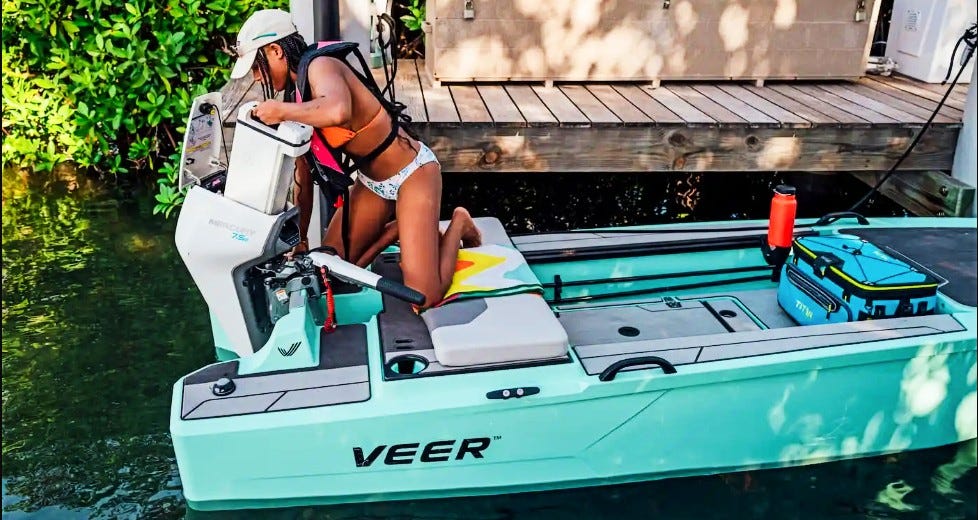
If an inflatable rows badly, a Veer doesn’t seem to be equipped to row at all. And she is shaped badly to paddle, especially if there’s only one paddler. The only way to do it is to sit with your legs hanging over the bow so you can paddle at centerline. It won’t be very satisfying trying to propel what amounts to a 425-pound raft that way.
As Tesla owners have learned, when the batteries die, auxiliary propulsion is a tow truck. The Veer people suggest carrying a second, expensive and proprietary battery pack.
The Veer’s heavy weight is a bit mystifying since one of the advantages of rotomolded plastic is that it enables the builder to produce lightweight craft. Veer boasts that their boat’s narrow beam2 allows it to be carried by a pick-up truck, but they neglect to mention that you would need a full-complement of pallbearers to lift it onto the bed.
So, maybe you don’t want to scrounge around for a bargain hard-bottom. As I mentioned earlier, West Marine sells a rotomolded pram for $750—a very stable little boat—and a handsome rotomolded dory for $760. Both of them are robust in their construction while weighing only about 110 pounds. (Biggest downsides: Neither has a transom drain nor limber holes to channel water.)
If anyone were to trick either of these out like Luv Tub, they would have a serviceable eBoat for well under $1,200. Which means you could outfit a fleet of ten, and still pay less than the price of one “affordable” Veer X13.
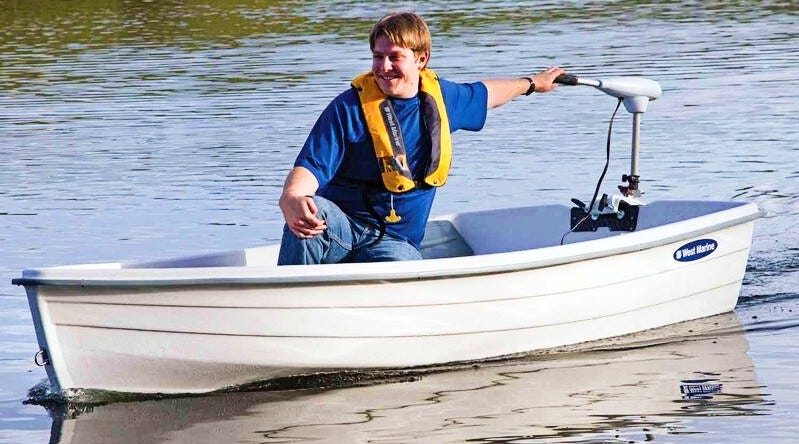
This is my favorite boating magazine description of the Veer:
“A gear to explore the water on your own terms”—these are the words the builders at Veer Boats use to describe their new 13-foot-rotomolded boat called the X13 (starting at $12,000). When you take into account that the boat has a draft of just over 6 inches and a narrow hull—both attributes appropriate for shallow and tight squeezing water passages, the motto makes sense.
First of all, who says “a gear” when referring to a boat. And what kind of “tight squeezing passages” require only four feet of beam? A drainage ditch?
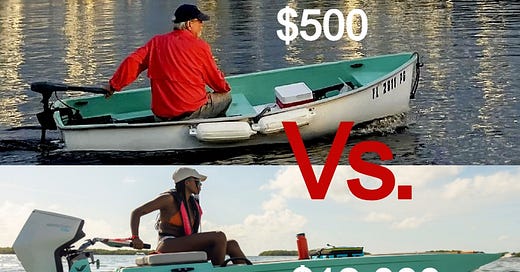



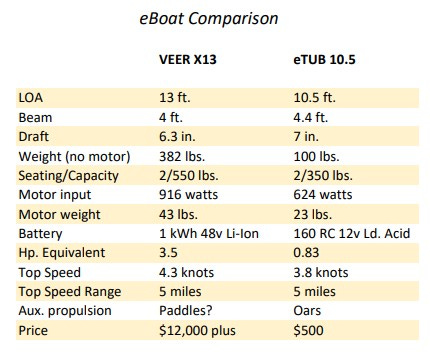
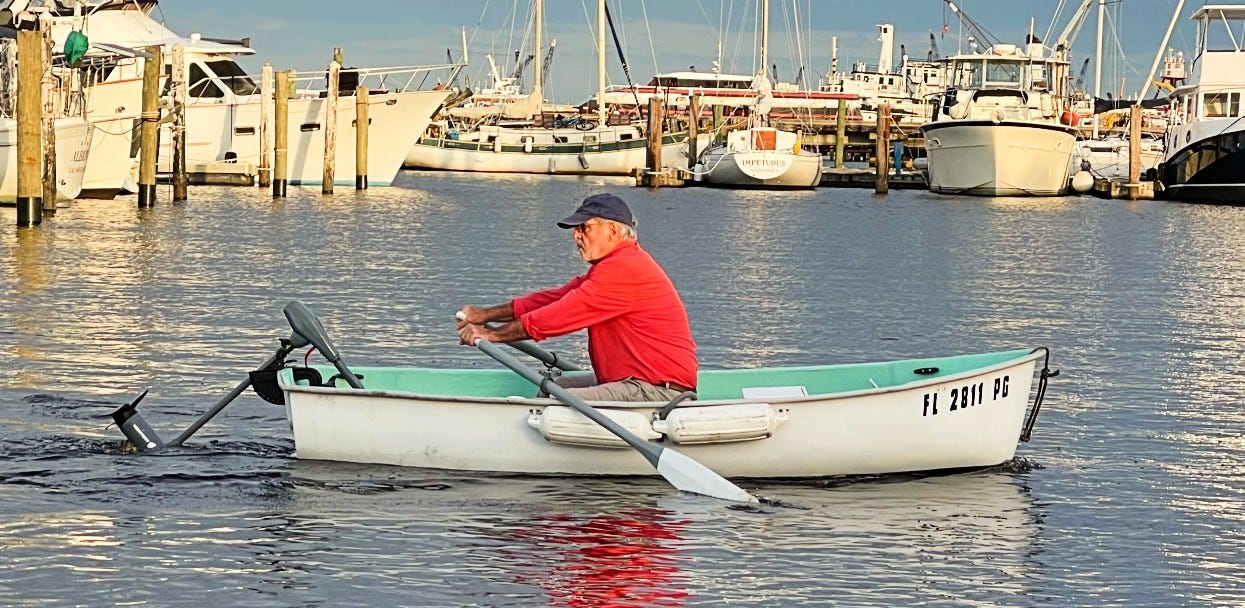
It would seem like a no-brainer "no" throwing away almost $11,000 for an overpriced dinghy one can neither comfortable row with or sail as there are no alternative sails, mast, boom, rudder or daggerboard for huge price.